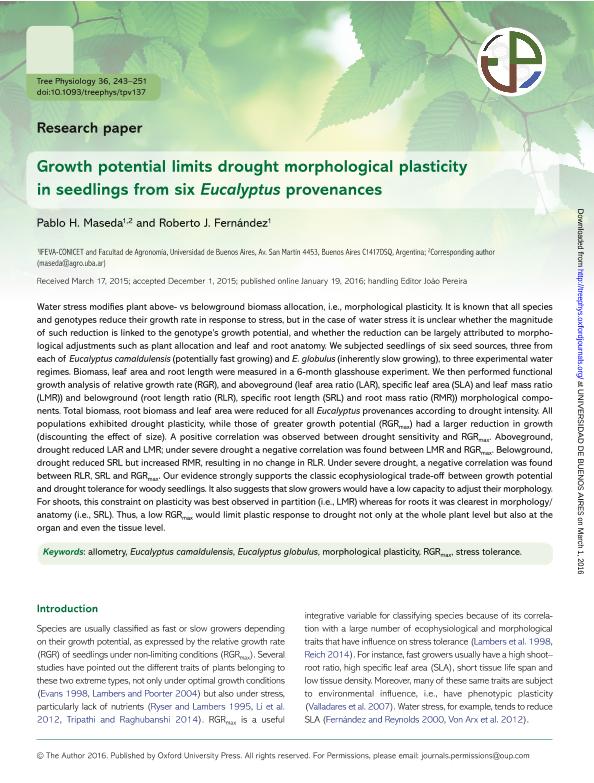Mostrar el registro sencillo del ítem
dc.contributor.author
Maseda, Pablo H.
dc.contributor.author
Fernandez Alduncin, Roberto Javier

dc.date.available
2018-07-06T17:04:46Z
dc.date.issued
2015-06
dc.identifier.citation
Maseda, Pablo H.; Fernandez Alduncin, Roberto Javier; Growth potential limits drought morphological plasticity in seedlings from six Eucalyptus provenances; Oxford University Press; Tree Physiology; 36; 2; 6-2015; 243-251
dc.identifier.issn
0829-318X
dc.identifier.uri
http://hdl.handle.net/11336/51526
dc.description.abstract
Water stress modifies plant above- vs belowground biomass allocation, i.e., morphological plasticity. It is known that all species and genotypes reduce their growth rate in response to stress, but in the case of water stress it is unclear whether the magnitude of such reduction is linked to the genotype's growth potential, and whether the reduction can be largely attributed to morphological adjustments such as plant allocation and leaf and root anatomy. We subjected seedlings of six seed sources, three from each of Eucalyptus camaldulensis (potentially fast growing) and E. globulus (inherently slow growing), to three experimental water regimes. Biomass, leaf area and root length were measured in a 6-month glasshouse experiment. We then performed functional growth analysis of relative growth rate (RGR), and aboveground (leaf area ratio (LAR), specific leaf area (SLA) and leaf mass ratio (LMR)) and belowground (root length ratio (RLR), specific root length (SRL) and root mass ratio (RMR)) morphological components. Total biomass, root biomass and leaf area were reduced for all Eucalyptus provenances according to drought intensity. All populations exhibited drought plasticity, while those of greater growth potential (RGRmax) had a larger reduction in growth (discounting the effect of size). A positive correlation was observed between drought sensitivity and RGRmax. Aboveground, drought reduced LAR and LMR; under severe drought a negative correlation was found between LMR and RGRmax. Belowground, drought reduced SRL but increased RMR, resulting in no change in RLR. Under severe drought, a negative correlation was found between RLR, SRL and RGRmax. Our evidence strongly supports the classic ecophysiological trade-off between growth potential and drought tolerance for woody seedlings. It also suggests that slow growers would have a low capacity to adjust their morphology. For shoots, this constraint on plasticity was best observed in partition (i.e., LMR) whereas for roots it was clearest in morphology/anatomy (i.e., SRL). Thus, a low RGRmax would limit plastic response to drought not only at the whole plant level but also at the organ and even the tissue level.
dc.format
application/pdf
dc.language.iso
eng
dc.publisher
Oxford University Press

dc.rights
info:eu-repo/semantics/openAccess
dc.rights.uri
https://creativecommons.org/licenses/by-nc-sa/2.5/ar/
dc.subject
Allometry
dc.subject
Eucalyptus Camaldulensis
dc.subject
Eucalyptus Globulus
dc.subject
Morphological Plasticity
dc.subject
Rgrmax
dc.subject
Stress Tolerance
dc.subject.classification
Agricultura

dc.subject.classification
Agricultura, Silvicultura y Pesca

dc.subject.classification
CIENCIAS AGRÍCOLAS

dc.title
Growth potential limits drought morphological plasticity in seedlings from six Eucalyptus provenances
dc.type
info:eu-repo/semantics/article
dc.type
info:ar-repo/semantics/artículo
dc.type
info:eu-repo/semantics/publishedVersion
dc.date.updated
2018-06-22T14:34:35Z
dc.journal.volume
36
dc.journal.number
2
dc.journal.pagination
243-251
dc.journal.pais
Reino Unido

dc.journal.ciudad
Oxford
dc.description.fil
Fil: Maseda, Pablo H.. Consejo Nacional de Investigaciones Científicas y Técnicas. Oficina de Coordinación Administrativa Parque Centenario. Instituto de Investigaciones Fisiológicas y Ecológicas Vinculadas a la Agricultura. Universidad de Buenos Aires. Facultad de Agronomía. ; Argentina
dc.description.fil
Fil: Fernandez Alduncin, Roberto Javier. Consejo Nacional de Investigaciones Científicas y Técnicas. Oficina de Coordinación Administrativa Parque Centenario. Instituto de Investigaciones Fisiológicas y Ecológicas Vinculadas a la Agricultura. Universidad de Buenos Aires. Facultad de Agronomía. ; Argentina
dc.journal.title
Tree Physiology

dc.relation.alternativeid
info:eu-repo/semantics/altIdentifier/doi/http://dx.doi.org/10.1093/treephys/tpv137
dc.relation.alternativeid
info:eu-repo/semantics/altIdentifier/url/https://academic.oup.com/treephys/article/36/2/243/2364702
Archivos asociados
